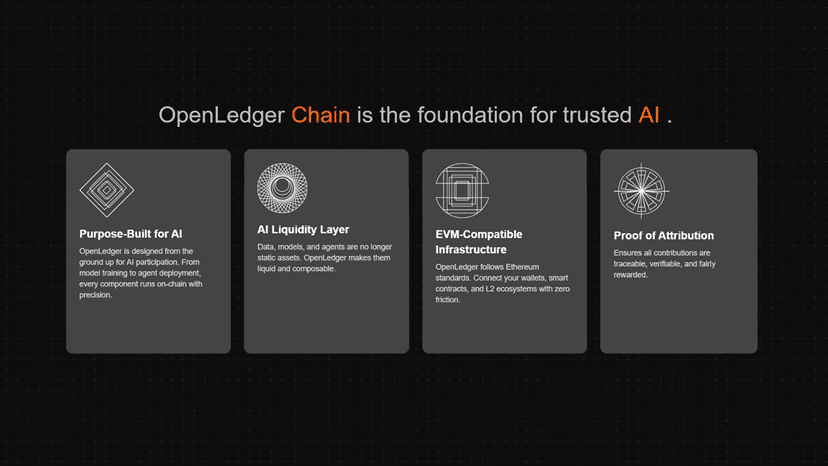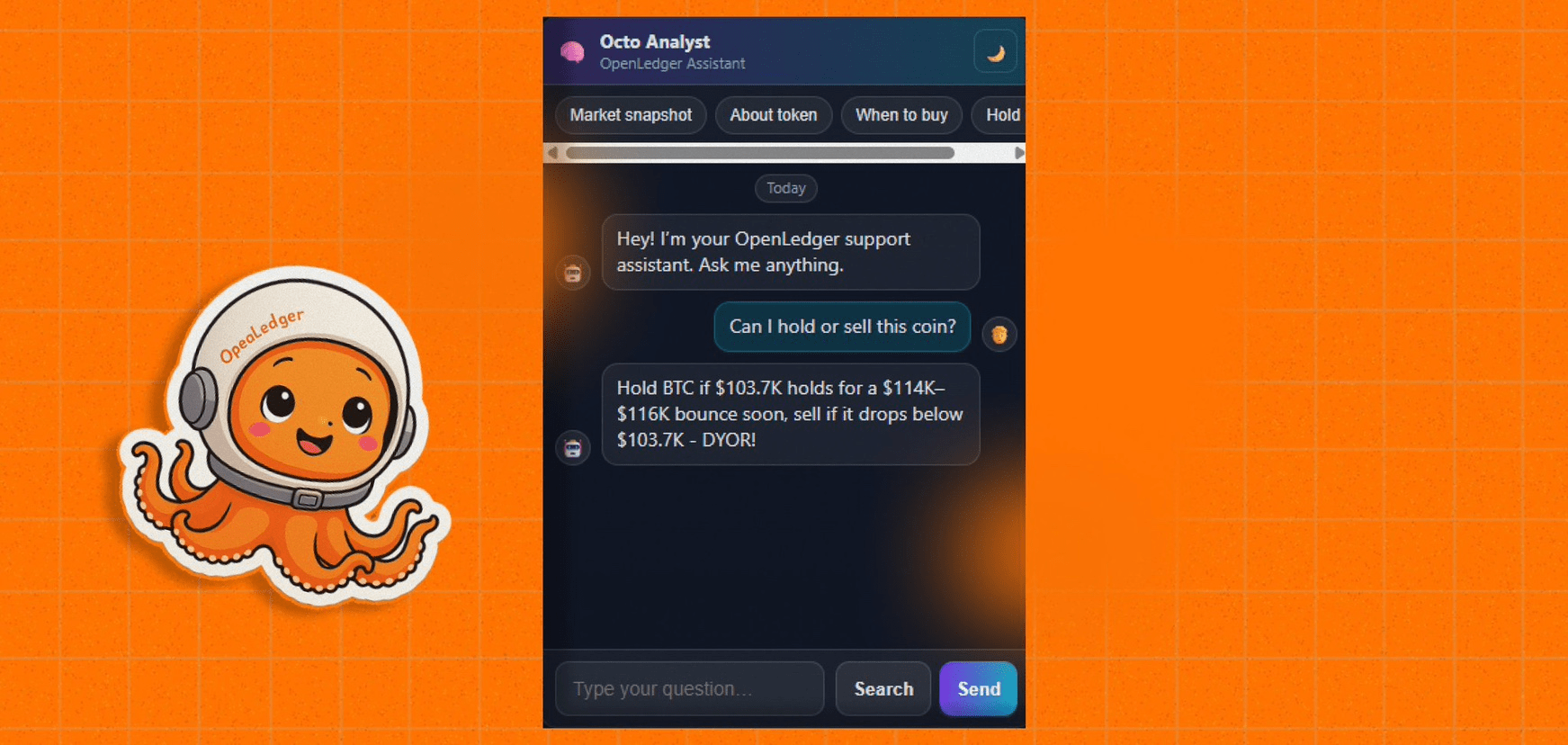 In the blockchain and cryptocurrency space, we are often attracted by the halo of mainstream projects like Bitcoin and Ethereum, while overlooking some less flashy but powerful projects. OpenLedger is such a project that maintains a low profile amid market noise but contains enormous potential. Today, let us delve into this decentralized finance platform centered around the OPEN token, unveiling its technological innovations and practical applications.@OpenLedger #OpenLedger
In the blockchain and cryptocurrency space, we are often attracted by the halo of mainstream projects like Bitcoin and Ethereum, while overlooking some less flashy but powerful projects. OpenLedger is such a project that maintains a low profile amid market noise but contains enormous potential. Today, let us delve into this decentralized finance platform centered around the OPEN token, unveiling its technological innovations and practical applications.@OpenLedger #OpenLedger
1. The Birth of OpenLedger: Filling the Gap in Cross-Chain Finance
OpenLedger was born in 2015, founded by Danish blockchain expert Ronny Boesing as a decentralized exchange (DEX) built on the BitShares blockchain. At that time, the crypto market was still in its infancy, with frequent vulnerabilities in centralized exchanges and continuous security issues for user assets. The emergence of OpenLedger was to address this pain point, providing a trading environment that does not require the custody of user assets.
Unlike many blockchain projects, OpenLedger did not start from scratch but chose to innovate and expand based on existing BitShares technology. This decision allows OpenLedger to inherit the Graphene technology architecture of BitShares, achieving a processing capacity of over 100,000 transactions per second, far exceeding the performance of the Ethereum and Bitcoin networks at that time.
Two, OPEN Token: A Multifunctional Token Beyond a Medium of Exchange
As the core of the OpenLedger ecosystem, the design of the OPEN token reflects the project team's deep understanding of blockchain token economics. Unlike most exchange tokens, OPEN is not limited to a single function of transaction fee discounts, but is endowed with multiple value attributes:
Governance Rights: OPEN holders can participate in voting on major platform decisions, including new feature development and fee adjustments. In a key vote in 2021, token holders collectively decided the strategic direction for the platform's expansion into cross-chain services, promoting the diversification of the project's ecosystem.
Revenue Sharing: The platform distributes a portion of its income to OPEN holders quarterly, creating a mechanism similar to dividends. In the second quarter of 2023, the platform distributed approximately $2 million in revenue, setting a new historical high.
Collateral Financing: Users can obtain loans for other digital assets by pledging OPEN tokens. For example, an investor from Singapore successfully obtained a short-term loan of $150,000 in Bitcoin by pledging 100,000 OPEN tokens in 2022 and timely closed the position for profit when the market rose.
Ecosystem Pass: The OPEN token allows holders access to various financial services within the OpenLedger ecosystem, from decentralized insurance to asset custody.
Three, Technical Architecture: The Art of Balancing Security and Efficiency
OpenLedger's technical architecture is built on the foundation of BitShares but achieves interoperability with multiple public chains through its self-developed cross-chain protocol. Its core technical features include:
Distributed Order Matching Engine: Using sharding technology to decentralize order processing across multiple nodes, significantly enhancing trading speed while maintaining decentralization. During an extreme market fluctuation in early 2023, when many centralized exchanges collapsed due to traffic overload, OpenLedger's order system continued to operate normally, providing users with uninterrupted trading services.
Smart Asset Management: Supporting digital assets controlled by smart contracts, allowing programmable asset behaviors. A typical case is a German blockchain startup that, in 2023, utilized OpenLedger's smart asset features to issue a stablecoin linked to the euro but with automatic liquidity management functions, successfully attracting over 10 million euros in market funding.
Zero-Knowledge Proof Security Layer: Adding privacy protection to user transactions without compromising the auditability of the blockchain. This technology helped the platform prevent a targeted attack on large accounts in 2022, protecting user assets worth approximately $8 million.
It is worth noting that OpenLedger completed a major technical upgrade in 2023, introducing a cross-chain protocol named 'Quantum Bridge' that achieved seamless connection with mainstream public chains like Ethereum, Polkadot, and Solana. This upgrade led to a 135% increase in platform trading volume within three months, and the price of the OPEN token subsequently rose by about 67%.
Four, Real-World Application Cases: A Leap from Theory to Practice
Case One: Transformation of Cross-Border Payments
In 2022, a cross-border e-commerce company headquartered in Malaysia began using OpenLedger for international settlements, replacing traditional banking channels. By integrating OpenLedger's API, the company achieved 24/7 round-the-clock settlement, reducing the payment cycle from the original 3-5 business days to an average of 4 hours, saving about $180,000 in transaction fees annually. More importantly, due to the liquidity mechanism of the OPEN token, the company no longer needs to maintain large reserves of local currencies across different countries, significantly reducing exposure to exchange rate risks.
Case Two: Breakthrough in Decentralized Lending Market
OpenLedger's lending platform 'OpenCredit' officially launched in early 2023, introducing a reputation-based credit scoring system. A smallholder farmer from Kenya gradually improved his credit score by establishing a good borrowing record on the platform, ultimately obtaining a low-interest loan of $50,000 to expand production without any physical collateral. This case demonstrates how OpenLedger leverages blockchain technology to break the geographical limitations of traditional finance, providing financial services to small and micro enterprises in underdeveloped areas.
Case Three: Innovative Practice of Asset Tokenization
In early 2024, a Spanish real estate developer completed a tokenized issuance of a commercial building on the OpenLedger platform, with a total value of 23 million euros. The project divided the property rights into 2.3 million tokens, allowing investors to purchase any number of tokens to gain corresponding ownership and rental income. This asset tokenization model not only lowers the investment threshold for commercial real estate (with a minimum investment of only 10 euros) but also provides unprecedented liquidity, allowing investors to trade their shares on OpenLedger at any time. By the first quarter of 2025, the average daily trading volume of the asset tokens reached about 80,000 euros, providing holders with flexible investment management options.
Five, Challenges and Future Outlook: Finding a Balance Between Opportunities and Risks
Despite OpenLedger's significant achievements in technology and application, the project still faces numerous challenges:
Regulatory Uncertainty: The global cryptocurrency regulatory environment remains in a state of evolution, and policy differences across countries bring complexity to OpenLedger's global expansion. To address this challenge, the project team established a dedicated compliance department in 2024 and actively communicated with regulatory agencies in various countries.
User Education Bottleneck: The operation of decentralized exchanges is more complex than centralized platforms, which is not user-friendly for newcomers. To address this issue, OpenLedger launched the 'Easy DEX' interface at the end of 2023, significantly simplifying user interaction processes, resulting in a 43% increase in new user retention rates.
Intensifying Competition: With the rise of DEXs like Uniswap and SushiSwap, OpenLedger is facing increasing market competition. To maintain competitiveness, the project plans to launch a Layer 2-based expansion solution by the end of 2025, further reducing transaction costs and enhancing user experience.
Looking to the future, OpenLedger's development strategy focuses on three key areas:
Financial Inclusion Expansion: Plans to expand services to at least 25 emerging market countries by 2026, focusing on areas with inadequate coverage of traditional banking services.
Enterprise-level Solutions: Developing customized blockchain financial services for corporate clients, including supply chain finance and cross-border settlements.
Web3 Identity and Reputation System: Building a decentralized identity verification and reputation system based on blockchain to provide a more secure and private user identification mechanism for financial services.
Six, Conclusion: Redefining the Boundaries of Decentralized Finance
In today's rapidly evolving blockchain technology, OpenLedger represents a development path that balances innovation and stability. Through the multi-layered value network built by the OPEN token, the project successfully transforms abstract blockchain concepts into practical financial solutions, bringing tangible value to global users.
Although OpenLedger may not be as well-known as Bitcoin and Ethereum, its pragmatic approach to solving real financial problems, along with its strategy of seeking balance between technology and compliance, demonstrates another possibility for success in cryptocurrency projects. As the global financial system accelerates its digital transformation, projects like OpenLedger may play an increasingly important role in future financial infrastructure.
For investors, the OPEN token represents not only an investment in a technological platform but also participation in a new type of financial ecosystem. In this ecosystem, the efficiency bottlenecks of traditional finance are broken, global asset flow is no longer limited by geography and intermediaries, and the democratization and inclusiveness of financial services become possible.
 As OpenLedger continues to improve its technical architecture and business model, we have reason to believe that this 'invisible giant in the blockchain world' will gain broader recognition and application in the coming years, injecting new vitality and possibilities into the global financial system.
As OpenLedger continues to improve its technical architecture and business model, we have reason to believe that this 'invisible giant in the blockchain world' will gain broader recognition and application in the coming years, injecting new vitality and possibilities into the global financial system.
\u003cm-51/\u003e\u003ct-52/\u003e\u003cc-53/\u003e